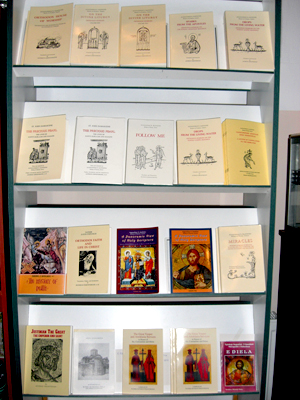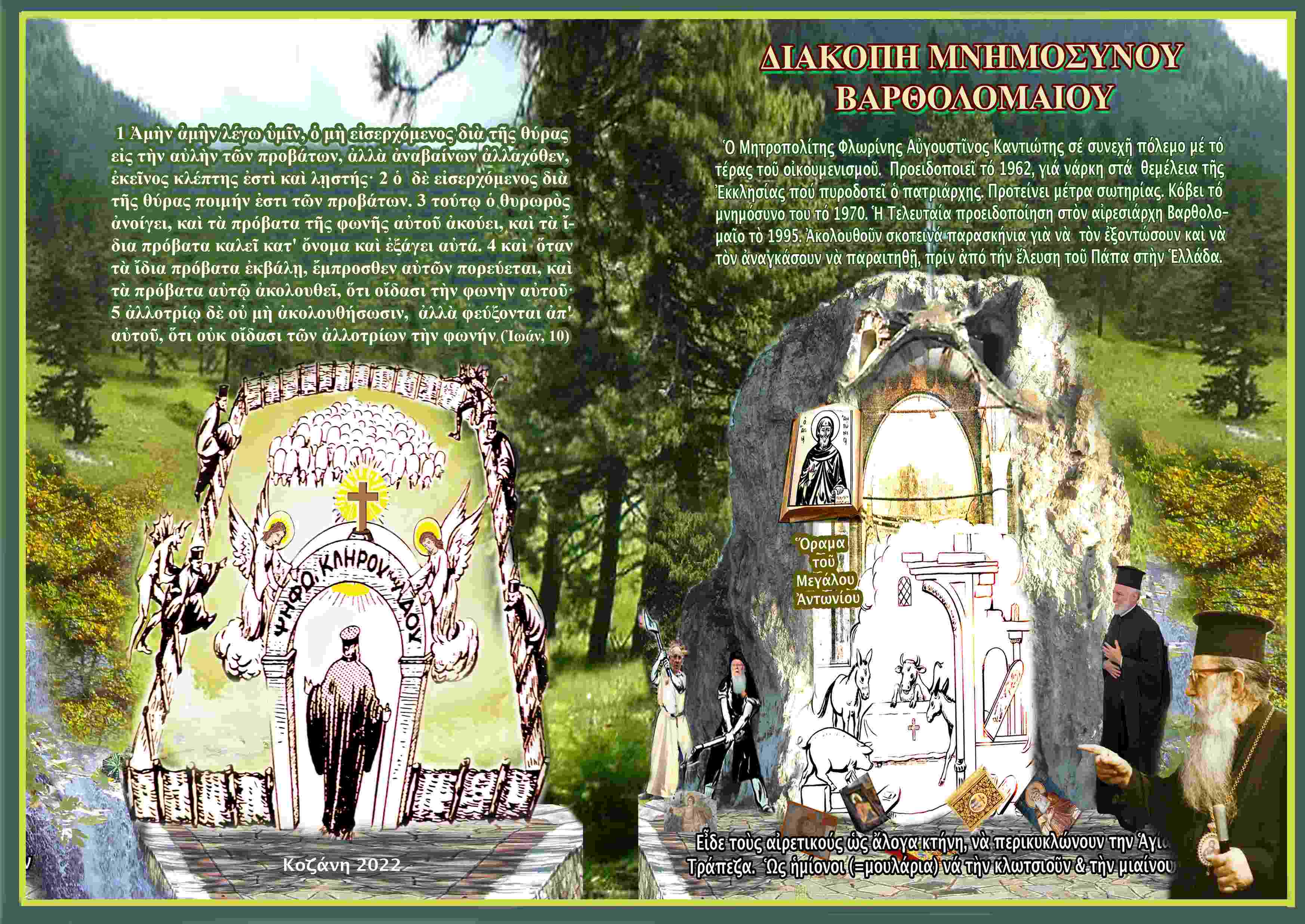THE GLORIOUS FLAG – THE SYMBOL OF FAIT
 Δεκ 11th, 2009 |
Δεκ 11th, 2009 |  Filed under: English
Filed under: English
THE GLORIOUS FLAG – THE SYMBOL OF FAITH
Απόσπσμα από το βιβλίο του πατρός Αυγουστίνου «Εις την Θείαν Λειτουργίαν, Πρακτικαί Ομιλίαι»!
[Η μετάφραση ολόκληρου τού βιβλίου (δύο τόμους) στα Αγγλλικά έγινε από τον ακούραστο εργάτη και αγωνιστή της Ορθοδοξίας, πνευματικόν τέκνον του πατρός Αυγουστίνου, πατέρα Αστέριο Γεροστέργιο. Προσφέρεται ταπεινά και με την εν Χριστώ αγάπη εις ψυχικήν ωφέλειαν Ορθοδόξων Χριστιανών απανταχού της γης και επισκεπτών της ιστοσελίδας του σεβαστού Γέροντος Αυγουστίνου
προς δόξαν του Τριαδικού μας Θεού].
 In our previous homily, we explained the expression “The doors, the doors, in wisdom let us attend. We spoke of the meaning this exhortation has. Heretics and unbelievers are not permitted to remain in church, and the faithful who remain should listen reverently and fix their thoughts on what is being said and done in the Liturgy. We said before and we repeat, that it is a sin when the celebrating priest recites the beautiful prayers and petition, read the Gospel and offers up the awesome Mystery, and the cantors chant: it is a sin to be there in body, but absent in spirit.
In our previous homily, we explained the expression “The doors, the doors, in wisdom let us attend. We spoke of the meaning this exhortation has. Heretics and unbelievers are not permitted to remain in church, and the faithful who remain should listen reverently and fix their thoughts on what is being said and done in the Liturgy. We said before and we repeat, that it is a sin when the celebrating priest recites the beautiful prayers and petition, read the Gospel and offers up the awesome Mystery, and the cantors chant: it is a sin to be there in body, but absent in spirit.
After “The doors, the doors…”, complete silence should prevail in the house of worship. Everyone is waiting for something important to be said – and that wich is heard immediately afterward is the Creed.
The Creed today is said by the reader. In the Russian and American Orthodox Churches, the entire congregation says it. This is not an innovation, but an ancient tradition. It would be good if this ancient custom were revived throughout the entire Church. In our Diocese, we ordered the Creed and the Lord’s Prayer to be said by the entire congregation. That way, the whole service of the Liturgy comes to life, and even the cold and indifferent person awakens when he hears the Creed being said aloud and feels that something worthy of attention is taking place.
And truly, the Creed is of great importance. It is called the sacred Symbol of our Faith. But what is a symbol? A symbol is something that gives us an immediate understanding of something accepted or believed. For example, the eagle in ancient times was a symbol, which when seen depicted on a flag, was understood to mean that the state which had such a flag was the most powerful in the world, the Roman Empire. Another symbol was the double-headed eagle, depicted mainly on the flags of the Byzantine Empire. Today, the two superpowers, Russia and United States, have respectively hammer and sickle, and 50 stars on their flags, while the Greek flag is the symbol of the Cross.
As the various countries of the world are distinguished from one another by the special symbol representing them on their flags, our Church, the Orthodox Church, is distinguished from all other religions and heresies by Her Creed, heard during the Liturgy. The Creed is the sacred Symbol of the Orthodox Church. The Creed is our glorious “flag”, a flag under which all the faithful have fought and will continue to fight.
It is common practice that when the people recite the Creed, the priest in the Sanctuary, also reciting it, shakes the Aer above the Precious Gifts. The Aer is a rectangular piece of cloth, usually red in color, with which the Precious Gifts are covered until this point in the service. Therefore, since whatever is said or done during the Divine Liturgy has its own special meaning, let us briefly see what this act represents.
Certain interpreters of the Divine Liturgy say that the priest fans the Aer to keep insects out of the Chalice. One of the more recent commentators says that once a lizard fell into the holy Chalice from the ceiling of the Sanctuary, and the pious priest ate the lizard because the body was soaked with the Blood of the God-Man. What faith and piety our priests had years ago! And what cold-heartedness and indifference exists today! The holy Chalice is considered an ordinary cup…
But there is another interpretation: the priest fans the Aer over the Precious Gifts to show that our Creed is not a false one, like the others humanity follows, but the true Creed. It is, as we have said, our sacred symbol, the glorious flag of Christendom, which always defeats its enemies. And just as soldiers, when they conquer a high hill, raise their flag on the summit, letting it wave as if shivering with emotion, so our Church, which is like an army that fights and defeats unbelievers and heretics with the blood of the Sanctified Lamb, raises the Aer symbolically like a flag. This moment is like proclaiming Her victories and triumphs. It is like repeating the God-inspired saying of St. John the Evangelist: “This is the victory that overcometh the world, our faith” (I John 5:4).
The Creed has its history. It was composed by two Ecumenical Synods, the First and Second. The First convened in 325 A.D. at Nicea of Bithynia, Asia Minor, during the reign of Constantine the Great. Three hundred and eighteen fathers and teachers of our Church, martyrs and confessors who suffered when the persecutions were still going on, condemned the heresy of the Arians. The latter taught that there were a time when Christ, the Son of God, did not exist. Arius, their leader, denied the Divinity of Christ, as do contemporary Jehovah’s Witnesses, the “spiritual” grandchildren of Arius.
The Second Ecumenical Synod took place in 381 A.D. at Constantinople during the reign of Theodosios the Great, with one hundred and fifty fathers and teachers in attendance. St. Gregory the Theologian acted as president of the Synod and condemned and excommunicated another heretic, Macedonios, who denied that the Holy Spirit was God.
The fathers and teachers of the First and Second Synods did not teach their own doctrines, but interpreted rightly the various passages of the Holy Scripture which the heretics distorted and misinterpreted. The fathers formulated a short statement of the most fundamental of all dogma (teachings), the Holy Trinity. It is to these fathers and teachers of the Church that we owe eternal gratitude. The heretics of every century blaspheme them, but the Orthodox Church glorifies them, and on the day of the commemoration chants the following hymn of praise:
“When the choir of holy Fathers assembled from the ends of the inhabited world, it formulated the doctrine that the Father and the Son and the Holy Spirit are of one essence and nature; and it transmitted clearly to the Church the mystery of Theology. Honoring them faithfully by praise, let us pronounce them blessed saying: O divine army, o soldiers of the camp of the Lord, who speak of God, o most radiant stars of the spiritual firmament, o invincible towers of the mystical Sion, o fragrant flowers of Paradise, o all-golden mouths of the Logos, o boast of Nicaea, and ornament of the inhabited world, intercede fervently for our souls.”
This chapter was taken from the book “ON THE DEVINE LITURGY – VOL.2” by Bishop Augoustinos N. Kantiotes.
e-mail: ibmgs3@verizon.net
www.orthodoxinfo.com/ibmgs



Add A Comment
You must be logged in to post a comment.